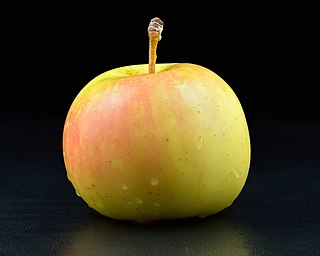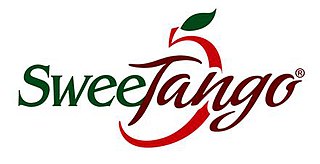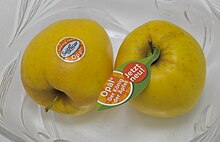
In botany, a fruit is the seed-bearing structure in flowering plants formed from the ovary after flowering.

Kiwifruit or Chinese gooseberry is the edible berry of several species of woody vines in the genus Actinidia. The most common cultivar group of kiwifruit is oval, about the size of a large hen's egg: 5–8 centimetres in length and 4.5–5.5 cm in diameter. It has a thin, fuzzy, fibrous, tart but edible light brown skin and light green or golden flesh with rows of tiny, black, edible seeds. The fruit has a soft texture with a sweet and unique flavour. In 2018, China produced half of the world total of kiwifruit.

The pineapple is a tropical plant with an edible fruit and the most economically significant plant in the family Bromeliaceae. The pineapple is indigenous to South America, where it has been cultivated for many centuries. The introduction of the pineapple to Europe in the 17th century made it a significant cultural icon of luxury. Since the 1820s, pineapple has been commercially grown in greenhouses and many tropical plantations. Further, it is the third most important tropical fruit in world production. In the 20th century, Hawaii was a dominant producer of pineapples, especially for the US; however, by 2016, Costa Rica, Brazil, and the Philippines accounted for nearly one-third of the world's production of pineapples.

Maclura pomifera, commonly known as the Osage orange, horse apple, hedge, or hedge apple tree is a small deciduous tree or large shrub, typically growing to 8 to 15 metres (30–50 ft) tall. The distinctive fruit, a multiple fruit, is roughly spherical, bumpy, 8 to 15 centimetres (3–6 in) in diameter, and turns bright yellow-green in the fall. The fruits secrete a sticky white latex when cut or damaged. Despite the name "Osage orange", it is not related to the orange. It is a member of the mulberry family, Moraceae. Due to its latex secretions and woody pulp, the fruit is typically not eaten by humans and rarely by foraging animals, giving it distinction as an anachronistic "ghost of evolution".

Carambola, also known as starfruit, is the fruit of Averrhoa carambola, a species of tree native to tropical Southeast Asia. The fruit is commonly consumed throughout Southeast Asia, the South Pacific, Micronesia, parts of East Asia, and the Caribbean. The tree is cultivated throughout tropical areas of the world.

The persimmon is the edible fruit of a number of species of trees in the genus Diospyros. The most widely cultivated of these is the Asian or Japanese persimmon, Diospyros kaki. Diospyros is in the family Ebenaceae, and a number of non-persimmon species of the genus are grown for ebony timber. In 2018, China produced about two-thirds of the world total of persimmons.

Horticulture is the agriculture of plants, mainly for food, materials, comfort and beauty for decoration. Horticulturists apply knowledge, skills, and technologies to grow intensively produced plants for human food and non-food uses and for personal or social needs. Their work involves plant propagation and cultivation with the aim of improving plant growth, yields, quality, nutritional value and resistance to insects, diseases and environmental stresses. They work as gardeners, growers, therapists, designers, and technical advisors in the food and non-food sectors of horticulture.

'Golden Delicious' is a yellow apple, one of the 15 most popular cultivars in the United States. It is not closely related to 'Red Delicious'.

A lenticel is a porous tissue consisting of cells with large intercellular spaces in the periderm of the secondarily thickened organs and the bark of woody stems and roots of dicotyledonous flowering plants. It functions as a pore, providing a pathway for the direct exchange of gases between the internal tissues and atmosphere through the bark, which is otherwise impermeable to gases. The name lenticel, pronounced with an, derives from its lenticular (lens-like) shape. The shape of lenticels is one of the characteristics used for tree identification.

The jackfruit, also known as jack tree, is a species of tree in the fig, mulberry, and breadfruit family (Moraceae). Its origin is in the region between the Western Ghats of southern India and the rainforests of Malaysia.

Annona is a genus of flowering plants in the pawpaw/sugar apple family, Annonaceae. It is the second largest genus in the family after Guatteria, containing approximately 166 species of mostly Neotropical and Afrotropical trees and shrubs. The generic name derives from anón, a Hispaniolan Taíno word for the fruit. Paleoethnobotanical studies have dated Annona exploitation and cultivation in the Yautepec River region of Medicoto approximately 1000 BC. It has several common names, including Guanabana, and Soursop.

Starburst is the brand name of a box-shaped, fruit-flavored soft taffy candy manufactured by The Wrigley Company, which today is a subsidiary of Mars, Incorporated, after Mars transferred the brand's production to it. Starburst has many different varieties, such as Tropical, Sour, FaveREDs, Watermelon, Very Berry, Superfruit, Summer Blast, and Original. The original flavours include: strawberry, lemon, orange, and cherry. However, the UK original flavours are black currant, lemon and lime, orange and strawberry. The tropical flavours include: strawberry banana, pineapple, mango melon, cherry and kiwi.

In botany, a berry is a fleshy fruit without a stone (pit) produced from a single flower containing one ovary. Berries so defined include grapes, currants, and tomatoes, as well as cucumbers, eggplants (aubergines) and bananas, but exclude certain fruits that meet the culinary definition of berries, such as strawberries and raspberries. The berry is the most common type of fleshy fruit in which the entire outer layer of the ovary wall ripens into a potentially edible "pericarp". Berries may be formed from one or more carpels from the same flower. The seeds are usually embedded in the fleshy interior of the ovary, but there are some non-fleshy exceptions, such as peppers, with air rather than pulp around their seeds.

Asimina triloba, the American papaw, pawpaw, paw paw, or paw-paw, among many regional names, is a small deciduous tree native to the eastern United States and Canada, producing a large, yellowish-green to brown fruit. It belongs to the genus Asimina in the same plant family as the custard-apple, cherimoya, sweetsop, ylang-ylang, and soursop.

An apple is an edible fruit produced by an apple tree. Apple trees are cultivated worldwide and are the most widely grown species in the genus Malus. The tree originated in Central Asia, where its wild ancestor, Malus sieversii, is still found today. Apples have been grown for thousands of years in Asia and Europe and were brought to North America by European colonists. Apples have religious and mythological significance in many cultures, including Norse, Greek, and European Christian tradition.

SweeTango is the brand designation of the cultivated apple 'Minneiska'. It is a patented cross breed between the 'Honeycrisp' and the Zestar! apple. The trademark name belongs to the University of Minnesota. The apple is a controlled and regulated product for marketing to the public. The apple is controlled and regulated for marketing, allowing only exclusive territories for growing. It has a sweet-tart taste that some food writers have described as something between brown sugar and spiced apple cider.
Arctic apple is the trademark for a group of patented apples that contain a nonbrowning trait introduced through biotechnology. They were developed through a process of genetic engineering by Okanagan Specialty Fruits Inc. Specifically, gene silencing reduces the expression of polyphenol oxidase (PPO), thus delaying the onset of browning. It is the first genetically engineered apple to be approved for commercial sale, though Innate potato varieties that were improved through biotechnology have also been approved for sale in the United States. The US Food and Drug Administration (FDA) in 2015, and the Canadian Food Inspection Agency, Government of Canada in 2017, determined that Arctic apples are as safe and nutritious as conventional apples. In 2019, product sales of the Arctic apple were expected in the United States, by evidence of sales plans for foodservice.

Envy is a trademarked brand of the Scilate apple variety. Scilate is the result of a cross between Royal Gala and Braeburn. It was developed in New Zealand by HortResearch, submitted for a patent in 2008 and patented in 2009.

The Indian Institute of Horticultural Research (IIHR) is an autonomous organization acting as a nodal agency for basic, strategic, anticipatory and applied research on various aspects of horticulture such as fruits, vegetable, ornamental, medicinal and aromatic plants and mushrooms in India. The institute has its headquarters in Bengaluru, Karnataka, India and is a subsidiary of Indian Council of Agricultural Research (ICAR), New Delhi, under the Ministry of Agriculture, India.



















